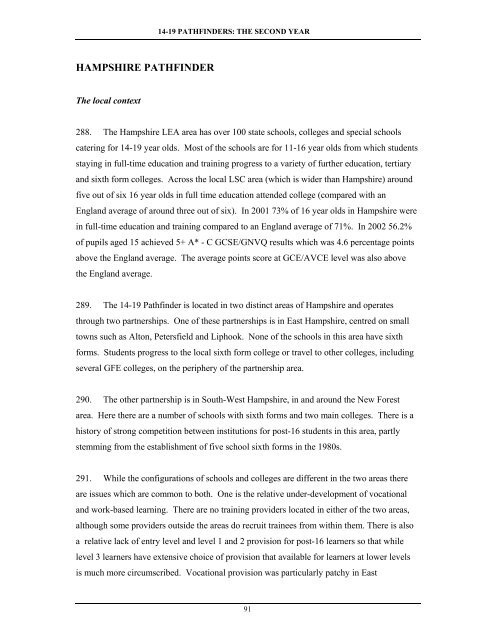Collaborative Approaches to 14-19 Provision - Communities and ...
Collaborative Approaches to 14-19 Provision - Communities and ...
Collaborative Approaches to 14-19 Provision - Communities and ...
- No tags were found...
Create successful ePaper yourself
Turn your PDF publications into a flip-book with our unique Google optimized e-Paper software.
<strong>14</strong>-<strong>19</strong> PATHFINDERS: THE SECOND YEARHAMPSHIRE PATHFINDERThe local context288. The Hampshire LEA area has over 100 state schools, colleges <strong>and</strong> special schoolscatering for <strong>14</strong>-<strong>19</strong> year olds. Most of the schools are for 11-16 year olds from which studentsstaying in full-time education <strong>and</strong> training progress <strong>to</strong> a variety of further education, tertiary<strong>and</strong> sixth form colleges. Across the local LSC area (which is wider than Hampshire) aroundfive out of six 16 year olds in full time education attended college (compared with anEngl<strong>and</strong> average of around three out of six). In 2001 73% of 16 year olds in Hampshire werein full-time education <strong>and</strong> training compared <strong>to</strong> an Engl<strong>and</strong> average of 71%. In 2002 56.2%of pupils aged 15 achieved 5+ A* - C GCSE/GNVQ results which was 4.6 percentage pointsabove the Engl<strong>and</strong> average. The average points score at GCE/AVCE level was also abovethe Engl<strong>and</strong> average.289. The <strong>14</strong>-<strong>19</strong> Pathfinder is located in two distinct areas of Hampshire <strong>and</strong> operatesthrough two partnerships. One of these partnerships is in East Hampshire, centred on small<strong>to</strong>wns such as Al<strong>to</strong>n, Petersfield <strong>and</strong> Liphook. None of the schools in this area have sixthforms. Students progress <strong>to</strong> the local sixth form college or travel <strong>to</strong> other colleges, includingseveral GFE colleges, on the periphery of the partnership area.290. The other partnership is in South-West Hampshire, in <strong>and</strong> around the New Forestarea. Here there are a number of schools with sixth forms <strong>and</strong> two main colleges. There is ahis<strong>to</strong>ry of strong competition between institutions for post-16 students in this area, partlystemming from the establishment of five school sixth forms in the <strong>19</strong>80s.291. While the configurations of schools <strong>and</strong> colleges are different in the two areas thereare issues which are common <strong>to</strong> both. One is the relative under-development of vocational<strong>and</strong> work-based learning. There are no training providers located in either of the two areas,although some providers outside the areas do recruit trainees from within them. There is alsoa relative lack of entry level <strong>and</strong> level 1 <strong>and</strong> 2 provision for post-16 learners so that whilelevel 3 learners have extensive choice of provision that available for learners at lower levelsis much more circumscribed. Vocational provision was particularly patchy in East91
















